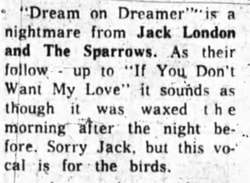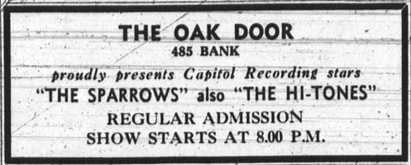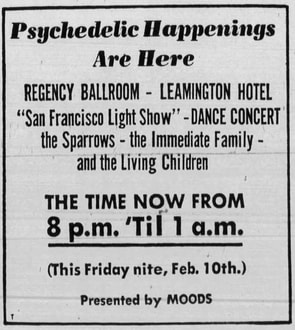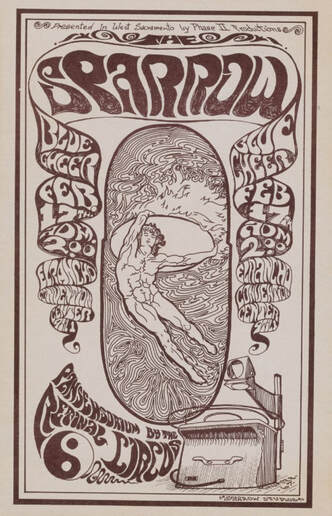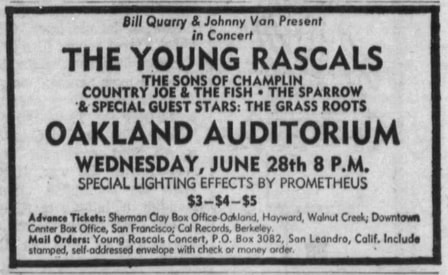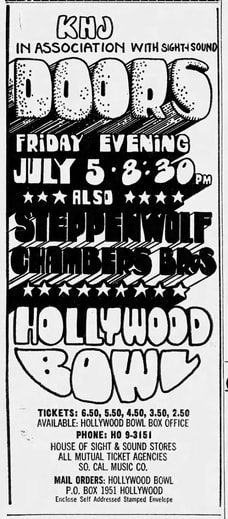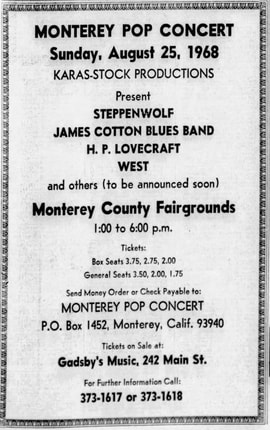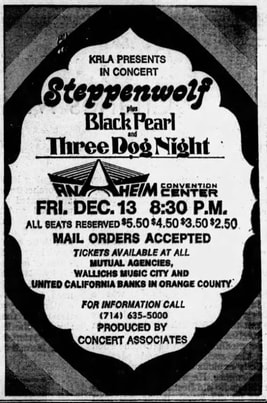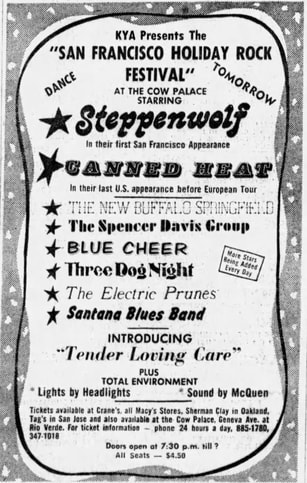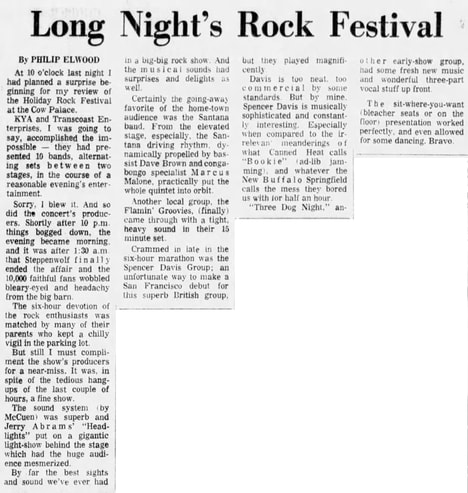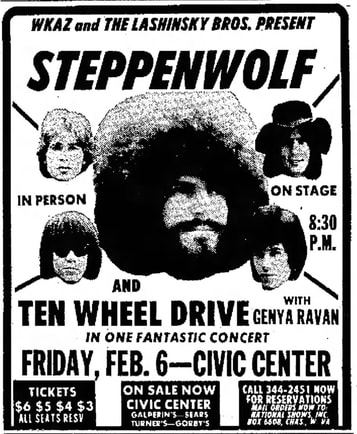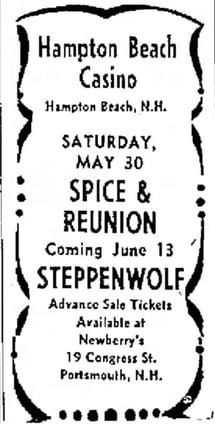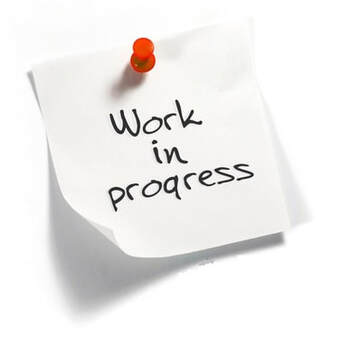If you enjoy what I have put together please consider donating any amount to support and help me to keep this valuable research going. Thanks!!
This day-by-day diary of Steppenwolf's live, studio, broadcasting and private activities is the result of three decades of research and interview work by Bruno Ceriotti, but without the significant contributions by other kindred spirits this diary would not have been possible. So, I would like to thank all the people who, in one form or another, contributed to this timeline: Ross Hannan, Corry Arnold, Michael Monarch, John Kay, Jerry Edmonton, Bob Cianci, Marc Myers, Leigh Stephens, Randy Holden, Chuck Taylor, Gerard Daily, Bill Ware, Hewitt Jackson, Greg Vick, Nick Warburton, Randy M. Foley, Debra Rowlands, John Copeland, John Porter, Serge Bellerose, Mark Scobac, Nick Blakey, Colin Hill, John H. Warburg, Jason Hillenburg, Dave Tothill, Rock Tour Database, Chrome Oxide, Los Angeles Free Press, Berkeley Barb, Peter Young, Paul White, Alex Casadei, Rob Branigin, Dan L., Merman, Joyce Canright, Bruce Tahsler, RPM Music Weekly, Kaleidoscope, Billboard, Dave Bingham, Tom Wilson, Dave Mickie, Frank Cameron, Doug Harper, Gerry Miskolczi, Michael Hochanadel, Jim Parrett, Frank Todd, "Kege" Legge, Harriet Wasser, Chuck Benson, Sandy Gardiner, Bryan Olney, Dave Johnson, Rockin Robbert, Johnny Onn, Debi Blonjeaux, Bill Miller, Frank Banyai, Philip Elwood, Mike Jaycock, Rob Frith, Domenic Priore, Brad Kelly, Jim Carrico, Sacramento Rock & Radio Museum, The Sacramento Bee, Judy Pocock, Stuart Robert Henderson, Trey Merrill, Joe Ringelstein, Lee Blu DiPintodi, Sue Williams, Madison Sale, Mark Kearney, Randy Ray, Hank Fox, Bob Mersereau, Scott Nuckles, Jeff McCurdy, The San Francisco Examiner, Oakland Tribune, Los Angeles Times, Boston Globe, Ottawa Journal, Sandy Gardiner, Ottawa Citizen, Daily Independent Journal, Sacramento Bee, Santa Cruz Sentinel, Independent Press Telegram, Fresno Bee, San Bernardino County Sun, Salinas Californian, John Week, Pomona Progress Bulletin, Charleston Daily Mail, Lubbock Avalanche Journal, The Berkshire Eagle, Portsmouth Herald, Sikeston Daily Standard, Hagerstown Daily Mail, News Journal (Mansfield, Ohio), Thumper, California State University Sacramento.
February 1964 (?)
Undoubtedly one of the greatest rock bands of all-time, Steppenwolf emerged from a Canadian blues rock outfit called The Sparrow. The story begins in Oshawa, on the Lake Ontario shoreline, where, duly inspired by The Beatles, a kid named Dave Marden (b. Wednesday, February 16, 1944, Toronto, Ontario, Canada), re-invented himself as an up-and-coming émigré singer from Liverpool (the same city of the Fab Four, of course!) named Jack London, and put together a British Invasion-style group called Jack London and The Sparrows with Dennis Edmonton (b. Dennis McCrohan) on lead guitar, Dave Hare on keyboards, and a couple of unknown players on bass and drums. Nedless to say, Marden even went as far as coaxing the others to "fake" English accents just like he did, in order to convince the audience and the media that they also had just arrived from Liverpool (this was, for example, the reason why Dennis McCrohan changed his surname to Edmonton, because they felt it sounded more British).
JACK LONDON AND THE SPARROWS #1 (FEBRUARY 1964 (?) - APRIL 1964 (?))
1) Dave Marden (aka Jack London) lead vocals
2) Dennis McCrohan (aka Dennis Edmonton) vocals, lead guitar
3) Dave Hare keyboards
4) ? bass
5) ? drums
1) Dave Marden (aka Jack London) lead vocals
2) Dennis McCrohan (aka Dennis Edmonton) vocals, lead guitar
3) Dave Hare keyboards
4) ? bass
5) ? drums
April 1964 (?)
After a couple of months or so, the unknown bass player and drummer where replaced respectively by Burt Enfield (b. Brent Maitland) and Dennis Edmonton's brother Jerry Edmonton (b. Gerald McCrohan - d. 1993 in a car crash in California).
After a couple of months or so, the unknown bass player and drummer where replaced respectively by Burt Enfield (b. Brent Maitland) and Dennis Edmonton's brother Jerry Edmonton (b. Gerald McCrohan - d. 1993 in a car crash in California).
JACK LONDON AND THE SPARROWS #2 (APRIL 1964 (?) - JULY 1964 (?))
1) Jack London
2) Dennis Edmonton
3) Dave Hare
4) Brent Maitland (aka Burt Enfield) bass
5) Gerald McCrohan (aka Jerry Edmonton) drums, vocals, harmonica
April - July 1964 (?): The Jubilee Pavilion (aka The Jube), 55 Lakeview Park Avenue, Oshawa, Lake Ontario shoreline, Ontario, Canada
Independent and beloved operator Owen McCrohan, the father of the Edmonton's brothers, directed the city-owned The Jubilee Pavilion at that time, so Jack London and The Sparrows played there regularly.
July 1964 (?)
After another couple of months or so, Dave Hare was replaced on keyboards by Conrad J. Feeny, aka 'C.J.'.
JACK LONDON AND THE SPARROWS #3 (JULY 1964 (?) - OCTOBER 1964)
1) Jack London
2) Dennis Edmonton
3) Burt Enfield
4) Jerry Edmonton
5) C.J. Feeny keyboards
July - September 1964 (?): The Jubilee Pavilion (aka The Jube), 55 Lakeview Park Avenue, Oshawa, Lake Ontario shoreline, Ontario, Canada
October 1964
Jack London and The Sparrows relocated to Toronto, the provincial capital of Ontario, in search of fame and fortune and soon after signed a recording contract with Capitol Records of Canada. It was supposedly at that point that Burt Enfield moved back to Oshawa, and the band replaced him with a local bass player named Bruce Palmer.
JACK LONDON AND THE SPARROWS #4 (OCTOBER 1964 - FEBRUARY 1965)
1) Jack London
2) Dennis Edmonton
3) Jerry Edmonton
4) C.J. Feeny
5) Bruce Palmer bass
1) Jack London
2) Dennis Edmonton
3) Jerry Edmonton
4) C.J. Feeny
5) Bruce Palmer bass
October 1964 (?): 'Sock Hop', Gymnasium, Leaside High School, 200 Hanna Road, Toronto, Ontario, Canada
One of the band's first Toronto appearances was at a United Appeal fund raising event, where the students over-enthusiastic acceptance of them was just another indication of their upcoming success. One newspaper man tabbed the whole thing "SPARROW-MONIUM" with pictures in the daily papers of the Sparrow-cut (the long tresses now identified with the singer) and a front page story about the devotion of one fan to the London-Sparrow image.
November 1964 (?): 'Dave Mickie's Club 11 Dance Party', CHCH TV (Channel 11), Hamilton, Ontario, Canada
Jack London and The Sparrows' appearance on this television music show sparked a mail and telephone response never before heard of. In an article appeared on RPM Music Weekly dated December 14, 1964, Paul White of Capitol tells to the newspaper that Capitol's switchboard had been barraged with calls, following the TV performance. The following day the TV station phones White to ask what to do with "all the mail."
Late November 1964
Jack London and The Sparrows' debut single, 'If You Don't Want My Love / It's Been One Of Those Days Today', was released in Canada. The disc, which was a chart climber across the country, was recorded at RCA Studios, 225 Mutual Street, Toronto, and produced by Stan Klees. Both songs were written by Jack London and Dennis Edmonton.
Saturday, December 19 - Sunday, December 20, 1964: 'Telethon for Variety Village', CHCH-TV (Channel 11), Telecentre, 38 Yorkville Avenue, downtown Toronto, Ontario, Canada
Jack London and The Sparrows were among the guests who appeared on a telethon television show for Variety Village, a local family-friendly fitness, sports and life skills facility. The show was broadcasted live non-stop from Saturday at 10:30pm to Sunday at 3:30pm.
Friday, December 25, 1964 (?): 'Liverpool School', CHUM-AM Radio Show, Toronto, Ontario, Canada
Jack London, apparently without The Sparrows, appeared on this radio show hosted by John Horan every Fridays from 9:00 to 10:00pm.
Saturday, December 26, 1964 (?): 'unknown title', CHIC 102.1 FM Radio Show, Brampton, Ontario, Canada
Supposedly started today, Jack London hosted a radio show for teenagers each Saturday from 1:00 to 5:00pm.
1964/65: The Avenue Road Club, 45 Avenue Road, Yorkville, Toronto, Ontario, Canada
"I remember looking out my window, and there was a band practicing at the Avenue Road Club," Judy Pocock recalls on June 24, 2006, in an interview with Stuart Robert Henderson for the latter's thesis Making the Scene: Yorkville and Hip Toronto in the 1960s (2007). "They had long hair! And they were the only long haired guys in the the neighbourhood. And they were Jack London and The Sparrows, which [became] Steppenwolf! I used to sit in my bedroon window and watch them practice. Wow. And, I thought, I like these guys."
January 1965
Jack London and The Sparrows' debut single, 'If You Don't Want My Love / It's Been One Of Those Days Today', was released in the US.
Saturday, January 23, 1965: 'The Joey Reynolds Show', WKBW TV (Channel 7), Buffalo, New York (broadcast date)
Jack London and The Sparrows appeared as "surprise guest" on this top TV bandstand show which aired every Saturday from 5:00 to 6:00pm in Upper New York state and Upper Canada only.
Friday, February 5, 1965: The Devil's Den, downstairs at the Avenue Road Supper Club, 53 Avenue Road, Yorkville, Toronto, Ontario, Canada
Early February 1965
Jack London and The Sparrows' second single, 'I'll Be The Boy / Dream On Dreamer', was released in only Canada. The disc, which was a chart climber across the country, was recorded at RCA Studios, 225 Mutual Street, Toronto, and produced by Stan Klees.
One of the band's first Toronto appearances was at a United Appeal fund raising event, where the students over-enthusiastic acceptance of them was just another indication of their upcoming success. One newspaper man tabbed the whole thing "SPARROW-MONIUM" with pictures in the daily papers of the Sparrow-cut (the long tresses now identified with the singer) and a front page story about the devotion of one fan to the London-Sparrow image.
November 1964 (?): 'Dave Mickie's Club 11 Dance Party', CHCH TV (Channel 11), Hamilton, Ontario, Canada
Jack London and The Sparrows' appearance on this television music show sparked a mail and telephone response never before heard of. In an article appeared on RPM Music Weekly dated December 14, 1964, Paul White of Capitol tells to the newspaper that Capitol's switchboard had been barraged with calls, following the TV performance. The following day the TV station phones White to ask what to do with "all the mail."
Late November 1964
Jack London and The Sparrows' debut single, 'If You Don't Want My Love / It's Been One Of Those Days Today', was released in Canada. The disc, which was a chart climber across the country, was recorded at RCA Studios, 225 Mutual Street, Toronto, and produced by Stan Klees. Both songs were written by Jack London and Dennis Edmonton.
Saturday, December 19 - Sunday, December 20, 1964: 'Telethon for Variety Village', CHCH-TV (Channel 11), Telecentre, 38 Yorkville Avenue, downtown Toronto, Ontario, Canada
Jack London and The Sparrows were among the guests who appeared on a telethon television show for Variety Village, a local family-friendly fitness, sports and life skills facility. The show was broadcasted live non-stop from Saturday at 10:30pm to Sunday at 3:30pm.
Friday, December 25, 1964 (?): 'Liverpool School', CHUM-AM Radio Show, Toronto, Ontario, Canada
Jack London, apparently without The Sparrows, appeared on this radio show hosted by John Horan every Fridays from 9:00 to 10:00pm.
Saturday, December 26, 1964 (?): 'unknown title', CHIC 102.1 FM Radio Show, Brampton, Ontario, Canada
Supposedly started today, Jack London hosted a radio show for teenagers each Saturday from 1:00 to 5:00pm.
1964/65: The Avenue Road Club, 45 Avenue Road, Yorkville, Toronto, Ontario, Canada
"I remember looking out my window, and there was a band practicing at the Avenue Road Club," Judy Pocock recalls on June 24, 2006, in an interview with Stuart Robert Henderson for the latter's thesis Making the Scene: Yorkville and Hip Toronto in the 1960s (2007). "They had long hair! And they were the only long haired guys in the the neighbourhood. And they were Jack London and The Sparrows, which [became] Steppenwolf! I used to sit in my bedroon window and watch them practice. Wow. And, I thought, I like these guys."
January 1965
Jack London and The Sparrows' debut single, 'If You Don't Want My Love / It's Been One Of Those Days Today', was released in the US.
Saturday, January 23, 1965: 'The Joey Reynolds Show', WKBW TV (Channel 7), Buffalo, New York (broadcast date)
Jack London and The Sparrows appeared as "surprise guest" on this top TV bandstand show which aired every Saturday from 5:00 to 6:00pm in Upper New York state and Upper Canada only.
Friday, February 5, 1965: The Devil's Den, downstairs at the Avenue Road Supper Club, 53 Avenue Road, Yorkville, Toronto, Ontario, Canada
Early February 1965
Jack London and The Sparrows' second single, 'I'll Be The Boy / Dream On Dreamer', was released in only Canada. The disc, which was a chart climber across the country, was recorded at RCA Studios, 225 Mutual Street, Toronto, and produced by Stan Klees.
February 1965
C.J. Fenny was replaced by a new keyboard player named Art Ayre, formerly of the Art Ayre Trio, the Art Ayre Quartet, and the Art Ayre Quintet. Bruce Palmer also quickly soured on the British affectations, so The Sparrows swapped bass players with The Mynah Birds, a "rival" local band, picking up Nick St. Nicholas for Palmer. St. Nicholas, whose real name was Klaus Karl Kassbaum, got his start in Scarborough, an administrative division in Toronto, while a student at R.H. King Collegiate Institute, and then at the Cedarbrae Collegiate Institute where he formed what he believes was that school's first rock 'n' roll band. After a stint at the Ontario College of Art in Toronto, he played in The Big Town Boys and later The Mynah Birds.
JACK LONDON AND THE SPARROWS #5 (FEBRUARY 1965 - MAY ?, 1965)
1) Jack London
2) Dennis Edmonton
3) Jerry Edmonton
4) Art Ayre piano, organ, harmonium, vocals
5) Klaus Karl Kassbaum (aka Nick St. Nicholas) bass, vocals
1) Jack London
2) Dennis Edmonton
3) Jerry Edmonton
4) Art Ayre piano, organ, harmonium, vocals
5) Klaus Karl Kassbaum (aka Nick St. Nicholas) bass, vocals
Sunday, unknown date, 1965: Café El Patio, 119 Yorkville Avenue, Yorkville, Toronto, Ontario, Canada
March 1965
Jack London and The Sparrows' third single, 'Our Love Has Passed / Sparrows and Daisies', was released in only Canada. The disc, which was a chart climber across the country, was recorded at RCA Studios, 225 Mutual Street, Toronto, and produced by Stan Klees.
March 1965
Jack London and The Sparrows signed a management contract with one of the most famous management firms in the world, RPM (Robert P. Marcucci) Enterprises Incorporated.
Friday, March 19, 1965: 'Teens Funarama', Massey Hall, 178 Victoria Street, Garden District, downtown Toronto, Ontario, Canada
Local promoter Bill Anthony arranged a sort of "Farewell to Jack London and The Sparrows" concert after the band announced that they will be leaving shortly for a US tour (that in the end never happened, by the way). Also on the bill: Robbie Lane & The Disciples, The Mynah Birds, David Clayton Thomas and The Quintet, The Big Town Boys, The Girlfriends, Jon and Lee and The Checkmates, Lynda Layne, Dave Mickie (MC).
Friday, April 16 - Saturday, April 17, 1965: The Devil's Den, downstairs at the Avenue Road Supper Club, 53 Avenue Road, Yorkville, Toronto, Ontario, Canada
Friday, April 23 - Saturday, April 24, 1965: The Devil's Den, downstairs at the Avenue Road Supper Club, 53 Avenue Road, Yorkville, Toronto, Ontario, Canada
Late April 1965
Jack London and The Sparrows' first and only album, 'Jack London and The Sparrows', was released in only Canada. The album, which was a big seller across the country, was recorded at RCA Studios, 225 Mutual Street, Toronto, and produced by Stan Klees.
Sunday, May 9, 1965: ‘After Four,’ CJOH-TV (Channel 13), Ottawa, Ontario, Canada (broadcast date)
Jack London and The Sparrows were the musical guests of this 30-minute teen television show hosted by John F. Bassett Jr. and Carol Goss, and that aired every Sunday from 5:30pm to 6:00pm. Also appeared on this episode David Sector, one of Canada’s youngest and most successful movie makers.
May ?, 1965
The May 17 issue of R.P.M., Canada's only music industry weekly magazine, reported in his Here & There news section that "The Sparrows have flown the tower of London. Jack London will now go it alone as will his group The Sparrows." Apparently there was a disagreement between Jack and the band on the material that should be played, because the singer was, as we know, obsessed by the British sound, while The Sparrows wanted to play the blues like The Rolling Stones. Another good reason of disagreement was also that Jack London cut himself a better royalty share with Capitol then the rest of the band.
March 1965
Jack London and The Sparrows' third single, 'Our Love Has Passed / Sparrows and Daisies', was released in only Canada. The disc, which was a chart climber across the country, was recorded at RCA Studios, 225 Mutual Street, Toronto, and produced by Stan Klees.
March 1965
Jack London and The Sparrows signed a management contract with one of the most famous management firms in the world, RPM (Robert P. Marcucci) Enterprises Incorporated.
Friday, March 19, 1965: 'Teens Funarama', Massey Hall, 178 Victoria Street, Garden District, downtown Toronto, Ontario, Canada
Local promoter Bill Anthony arranged a sort of "Farewell to Jack London and The Sparrows" concert after the band announced that they will be leaving shortly for a US tour (that in the end never happened, by the way). Also on the bill: Robbie Lane & The Disciples, The Mynah Birds, David Clayton Thomas and The Quintet, The Big Town Boys, The Girlfriends, Jon and Lee and The Checkmates, Lynda Layne, Dave Mickie (MC).
Friday, April 16 - Saturday, April 17, 1965: The Devil's Den, downstairs at the Avenue Road Supper Club, 53 Avenue Road, Yorkville, Toronto, Ontario, Canada
Friday, April 23 - Saturday, April 24, 1965: The Devil's Den, downstairs at the Avenue Road Supper Club, 53 Avenue Road, Yorkville, Toronto, Ontario, Canada
Late April 1965
Jack London and The Sparrows' first and only album, 'Jack London and The Sparrows', was released in only Canada. The album, which was a big seller across the country, was recorded at RCA Studios, 225 Mutual Street, Toronto, and produced by Stan Klees.
Sunday, May 9, 1965: ‘After Four,’ CJOH-TV (Channel 13), Ottawa, Ontario, Canada (broadcast date)
Jack London and The Sparrows were the musical guests of this 30-minute teen television show hosted by John F. Bassett Jr. and Carol Goss, and that aired every Sunday from 5:30pm to 6:00pm. Also appeared on this episode David Sector, one of Canada’s youngest and most successful movie makers.
May ?, 1965
The May 17 issue of R.P.M., Canada's only music industry weekly magazine, reported in his Here & There news section that "The Sparrows have flown the tower of London. Jack London will now go it alone as will his group The Sparrows." Apparently there was a disagreement between Jack and the band on the material that should be played, because the singer was, as we know, obsessed by the British sound, while The Sparrows wanted to play the blues like The Rolling Stones. Another good reason of disagreement was also that Jack London cut himself a better royalty share with Capitol then the rest of the band.
THE SPARROWS #1 (MAY ?, 1965 - SEPTEMBER ??, 1965)
1) Dennis Edmonton
2) Jerry Edmonton
3) Art Ayre
4) Nick St. Nicholas
Tuesday, May 11 - Saturday, May 15, 1965: Mersey Club (formerly Penny Farthing), 112 Yorkville Avenue, Yorkville, Toronto, Ontario, Canada
Mid/Late May 1965
Jack London and The Sparrows' (posthumous) fourth and last single, 'Give My Love To Sally / Take It Slow', was released in only Canada. The disc, which was a chart climber across the country, was recorded at RCA Studios, 225 Mutual Street, Toronto, and produced by Stan Klees.
Friday, May 28 - Sunday, May 30, 1965: 'Teens Funarama', The Terrace, 68-88 Mutual Street, Garden District, downtown Toronto, Ontario, Canada
These shows were promoted by Bill Anthony and Dave Courtin. Also on the bill: The Guess Who, J.B. and The Playboys, The Liverpool Set, Robbie Lane, The Big Town Boys, Derek & Ed, Little Caesar and The Consuls, The Allan Sisters, Paupers, Shirley Matthews, David Clayton-Thomas, Jayson King,
June ?, 1965
The Sparrows' first and only single, 'Hard Times With The Law / Meet Me After Four', was released in only Canada. The disc, which was a chart climber across the country, was recorded at RCA Studios, 225 Mutual Street, Toronto, and produced by Stan Klees.
June 1965: 'Mickie A Go Go', CHCH TV (Channel 11), Hamilton, Ontario, Canada
The Sparrows appeared on the first episode of this new television music show hosted by Dave Mickie. Also appeared: Little Caesar and The Consuls, Greg Hamon, Shirley Matthews, The Charmaines, The Big Town Boys, Jayson King.
Friday, August 6 - Sunday, August 8, 1965: Charlie Brown's Coffee House, 158 Cumberland Street, Yorkville, Toronto, Ontario, Canada
One show each day, started at 8:30pm.
Mid August 1965 - Early September 1965
The Sparrows did a 3-week tour of Ontario, one of the 13 provinces and territories of Canada. Among others, they played in the city of Kingston in the region of Eastern Ontario, and in the city of Port Arthur in the region of Northern Ontario.
Early September 1965: Hallmark Studios, 22 Sackville Street, Corktown, Toronto, Ontario, Canada
Right after their return from their 3-week tour of Ontario, The Sparrows began the recording of some new great original tunes for their next Capitol release with the production in the hands of Stan Klees, as usual.
Monday, September 27, 1965
The today issue of R.P.M., Canada's only music industry weekly magazine, reported in his The Bigland Bulletin news section that "The Sparrows have added two new men to their ranks, having replaced Art Ayre on piano with organist John Goldsby and also added the rhythm guitar who played with the famous Byrds from the U.S.A." Well, first of all John Goldsby's surname was actually Goadsby, although he was known with his stage name of Goldy McJohn by then (John Kay called him 'Goldy', a spin on Goadsby, so there would not be two Johns in the band, while 'McJohn' is a takeoff of the Edmonton brothers, who were good friends of him), and second the unnamed guitar player who allegedly "played with The Byrds" was Joachim Fritz Krauledat, a German émigré known with the stage name of John Kay. The son of a German soldier killed by Soviet Union troops before he was born, John escaped with his mother from East Germany to West Germany in 1948, and then they emigrated to Toronto in 1958, and later to Santa Monica, California, in 1964. It was there that he start a career as a folk singer, playing regularly in coffee house and clubs such as the New Balladeer in West Los Angeles. So, yes, he played in L.A. at the same time of The Byrds, and maybe he even known them, but he never played with them to be clear. Anyway, to added confusion, the March 28, 1966, issue of R.P.M. mentioned their still unnamed new member again as formerly of The Byrds, but this time they added that he was the guy who wrote one of their hits songs, 'He Was A Friend Of Mine'. Well, actually it was Jim McGuinn, a real Byrd, who rewrote the lyrics of that old traditional folk song, so maybe the Canadian media really thought that McGuinn was The Sparrows' new member? who knows! Fake news aside, John Kay wound up in Toronto again in 1965 and quickly became a popular performer in Yorkville too, playing blues and folk at The Half Beat at 47 Avenue Road, Yorkville, for three consecutive weekends on July 16-17, 23-24 and 30-31. That's where the rest of The Sparrows found him. "We were walking around outside the Avenue Road Club, and I ran into John Kay," confirms Nick St. Nicholas in an interview with Mark Kearney and Randy Ray for their book As The Years Goes By… Conversations with Canada's Folk, Pop & Rock Pioneers (2017). "Somehow we got together and he started singing and playing and I loved the sound."
THE SPARROWS #2 (SEPTEMBER ??, 1965 - JANUARY 1966) / THE SPARROW #1 (JANUARY 1966 - JUNE ?, 1967)
1) Dennis Edmonton
2) Jerry Edmonton
3) Nick St. Nicholas
4) John Raymond Goadsby (aka Goldy McJohn) organ, vocals
5) Joachim Fritz Krauledat (aka John Kay) vocals, harmonica, rhythm guitar
Late September 1965: Hallmark Studios, 22 Sackville Street, Corktown, Toronto, Ontario, Canada
The new lineup of The Sparrows complete the recording of four more sides for Capitol with Stan Klees as producer. Three of them were written by Dennis Edmonton.
Saturday, October 2, 1965: The Oak Door, 485 Bank Street, Ottawa, Ontario, Canada
Also on the bill: The Hi-Tones. One show, started at 8pm.
The new lineup of The Sparrows complete the recording of four more sides for Capitol with Stan Klees as producer. Three of them were written by Dennis Edmonton.
Saturday, October 2, 1965: The Oak Door, 485 Bank Street, Ottawa, Ontario, Canada
Also on the bill: The Hi-Tones. One show, started at 8pm.
December 1965: 'Ho Ho A-Go-Go', Club 888, 888 Yonge Street, Yorkville, Toronto, Ontario, Canada
A benefit show promoted by CHUM, a local radio station, to supply toys to St. Vincent de Paul Chuch and School. CHUM's deejays Bob McAdorey and Duff Roman, plus Ron Scribner of the Bigland Agency, hosted the show, which included some acts from the Bigland Agency himself, such as The Sparrows, J.B. and The Playboys, Shawn and her brother Jay Jackson, Jay Smith, and many others.
Saturday, December 25, 1965: Gogue Inn, Danforth Avenue East at the end of the street car line the Luttrell loop, Toronto, Ontario, Canada
Also on the bill: Bobby Kris & The Imperials, The Twilights.
Monday, January 3, 1966: Chez Monique, 88 Yorkville Avenue, Yorkville, Toronto, Ontario, Canada
Although this is the only confirmed date I've found so far, apparently The Sparrows played here regularly between 1965 and 1966.
Monday, February 7, 1966
The today issue of R.P.M., Canada's only music industry weekly magazine, reported in his Elvira Capreese Says… news section that "The Sparrows are now [January] 'the SPARROW' (singular) and have just finished a session."
Sunday, February 13, 1966: Massey Hall, 178 Victoria Street, Garden District, downtown Toronto, Ontario, Canada
The show was promoted by Gem 3 Star Productions. Also on the bill: Gary Lewis and The Playboys, Bobby Kris and The Imperials.
Early/Mid April 1966: RCA Studios, 225 Mutual Street, Toronto, Ontario, Canada
Wednesday, April 13, 1966: 'Dave "CJBQ" Charles Spectacular', Belleville Armouries, 187 Pinnacle Street, Belleville, Ontario, Canada
Thursday, April 28, 1966: unknown recording studio, New York City, New York
Not content to play the usual Top 40 tunes, the Sparrow moved to New York City where they recorded some demos today, and later on June 6, who eventually helped them to land a deal with Columbia Records. "We had attracted a young, well-off Canadian businessman who offered to be our manager who had connections in New York," recalls John Kay in an interview with Marc Myers for his book Anatomy of a Song: The Inside Stories Behind 45 Iconic Hits (2016). "Our demos helped us land a deal with Columbia Records, but it never amounted to anything more than a misunderstanding. We wanted to record an album and Columbia wanted us to cut radio-friendly singles." Anyway, today the Sparrow recorded three songs: 'Twisted', 'Goin' To California', and 'Square Headed People'. All of them were later released in their posthumous album, 'The Best of John Kay & Sparrow - Tighten Up Your Wig' (1993), while only 'Square Headed People' was also later released in their posthumous album, 'John Kay and The Sparrow' (Columbia CS 9758), in February 1969. By the way, when the band arrived in the Big Apple, someone stolen Jerry Edmonton's Ludwig drums kit from the band's station wagon parked in front of the Hotel Albert in Manhattan.
Spring/Summer 1966: The Jet Set, Manhattan, New York City, New York
Spring/Summer 1966: The Barge, Dune Road, East Quogue, Suffolk County, New York
Sunday, June 5, 1966: Arthur's Tavern, 57 Grove Street, b/w South 7th Avenue and Bleecker Street, West Village, Greenwich Village, Lower Manhattan, Manhattan, New York City, New York
Tuesday, June 7 - Monday, June 20 (?), 1966: The Downtown discoteque, Greenwich Village, Manhattan, New York City, New York
Started on June 7, The Sparrow were booked to play here for two weeks, plus two future one-week options. "We alternated weeks with the Chambers Brothers, [and] Bette Middler was the coat-check girl there," John Kay recalls in an interview with Marc Myers for his book Anatomy of a Song: The Inside Stories Behind 45 Iconic Hits (2016).
Monday, August 8, 1966
The Sparrow's first single, 'Tomorrow's Ship / Isn't It Strange', was released simultaneously in Canada and in the US. Originally the single was planned to be released in early July. Later that year was also released in the UK and France. "Our only [sic] release was 'Tomorrow's Ship,' which someone sarcastically referred to as 'No. 49 with an anchor'," John Kay recalls in an interview with Marc Myers for his book Anatomy of a Song: The Inside Stories Behind 45 Iconic Hits (2016). The B side, 'Isn't It Strange', was "an experimental song that included me using a bottleneck on my guitar with tons of echo," John adds. "I played these creeping, high-pitched melodic little things that sat on top of a slow, pulsating track. It sounded like a good idea here."
September 1?, 1966: The Downtown discoteque, Greenwich Village, Manhattan, New York City, New York
October 1966 (?)
With only a short time left on their visas, The Sparrow packed their instruments into a U-Haul and drove non-stop to Los Angeles, California, to find work. "We got our chops together in New York, since we could stretch out on much of the bluesier stuff we were playing," John Kay recalls in an interview with Marc Myers for his book Anatomy of a Song: The Inside Stories Behind 45 Iconic Hits (2016). "But none of it was really going anywhere. Eventually, I told guys we should be in Los Angeles, not New York. We moved out there, checking into the Tropicana Motel on Santa Monica Boulevard. All of the bands stayed there, and it had a cool diner that was a musician's hang."
Sunday, October 30, 1966: 'A Freak Out Freak In Freak Up Freak Down Halloween Costume Mostly Paint Genitals Must Be Covered Dance', Dave Hull's Hullabaloo, 6230 Sunset Boulevard, Downtown Hollywood, Los Angeles County, California
Also on the bill: The Daily Flash. The show was presented by Vito Paulekas, his wife Sue, and their late baby child Godot.
November 1966: Whisky à Go Go, 8901 Sunset Boulevard at Clark Street, West Hollywood, Los Angeles County, California
The Sparrow opened for The Sir Douglas Quintet for a week.
Fall 1966: It's A Boss, 8433 Sunset Boulevard, West Hollywood, Los Angeles County, California
Fall 1966: Club Galaxy, 8917 Sunset Boulevard, West Hollywood, Los Angeles County, California
December ?, 1966
When the gigs ran out in L.A., The Sparrow moved north to San Francisco, California. In the meantime, immigration officials threatened to send band members back to Canada, but an extension was granted. "Everything was going well until the Sunset Strip riots in November '66, when local merchants called the police to clear nightly crowds of loitering kids," John Kay recalls in an interview with Marc Myers for his book Anatomy of a Song: The Inside Stories Behind 45 Iconic Hits (2016). "After the riots, most clubs in West Hollywood admitted only people who were twenty-one or older. We were effectively starving for work. So we moved up to San Francisco."
Thursday, December 8 - Thursday, December 22, 1966: ‘Sound Show,’ The Ark, Gate 6, Sausalito, Marin County, California
Also on the bill: The Sons Of Champlin, The New Freudian Slips. On December 16 and 17, the Sparrow and the Sons of Champlin played the all-nighter shows from 2am to 6am, because for the evening shows (9pm to 2am) they were already booked at the Avalon Ballroom (see below).
Friday, December 16 - Saturday, December 17, 1966: 'Dance Concert', Avalon Ballroom, 1268 Sutter Street at Van Ness Street, Polk Gulch, San Francisco, California
Also on the bill: The Sons Of Champlin, The Youngbloods. Lights by Ben Van Meter and Roger Hillyard. These shows, which lasted from 9:00pm to 2:00am each day, were presented by Family Dog, a production company founded some months earlier by the great late Chet Helms, manager of Big Brother and The Holding Company.
Monday, December 19, 1966
The Sparrow's second and last single, 'Green Bottle Lover / Down Goes Your Love Life', was released only in the US.
Friday, January 13 - Sunday, January 14, 1967: Avalon Ballroom, 1268 Sutter Street at Van Ness Street, Polk Gulch, San Francisco, California
Also on the bill: Moby Grape, Charlatans. Lights by Roger Hillyard & Ben Van Meter. These shows, which lasted from 9:00pm to 2:00am each day, were presented by Family Dog.
Saturday, January 14 - Sunday, January 15, 1967: Goman's Gay 90s, 345 Broadway, North Beach, San Francisco, California
One show each day, started at 2:00am.
Friday, February 3 - Saturday, February 4, 1967: 'The Dance Of The Moons', Avalon Ballroom, 1268 Sutter Street at Van Ness Street, Polk Gulch, San Francisco, California
Also on the bill: Country Joe and The Fish, Kaleidoscope. Lights by Roger Hillyard & Ben Van Meter. These shows, which lasted from 9:00pm to 2:00am each day, were presented by Family Dog.
Friday, February 10, 1967: 'Dance-Concert - This Is It - Psychedelic Happenings Are Here - The New World Has Hit Oakland', Regency Ballroom, Leamington Hotel, 1814 Franklin Street, Oakland, Alameda County, California
The band was advertised as The Sparrows [sic]. Also on the bill: The Wildflower, The Living Children, The Immediate Family. Lights by San Francisco Light Show. The show, which lasted from 8:00pm to 1:00am, was presented by Moods (or Funny Co.).
Friday, February 17, 1967: Convention Center, 17-acre Hotel El Rancho Resort, 1075 West Capitol Avenue, West Sacramento, Yolo County, California
Also on the bill: Blue Cheer. Lights by The Retinal Circus. The show, which lasted from 9pm to 1am, was presented by Phase II Productions.
Saturday, February 18, 1967: The Ark, Gate 6, Sausalito, Marin County, California
A breakfast show from 2:00am to 6:00am (so it was actually Sunday, February 19).
Saturday, February 25, 1967: unknown recording studio, Los Angeles, California
"One day, Columbia producer David Rubinson came up to hear us. He was sent by the label to determine if they should drop us or record us again," John Kay recalls in an interview with Marc Myers for his book Anatomy of a Song: The Inside Stories Behind 45 Iconic Hits (2016). "He brought us down to L.A. to record a few blues-rock tracks, but it didn't work out, and Columbia released us from our contract."
Friday, March 3 - Saturday, March 4, 1967: Avalon Ballroom, 1268 Sutter Street at Van Ness Street, Polk Gulch, San Francisco, California
Also on the bill: Country Joe and The Fish, The Doors. Lights by Roger Hillyard & Ben Van Meter. These shows, which lasted from 9:00pm to 2:00am each day, were presented by Family Dog.
Sunday, March 5, 1967: 'Benefit for Newstage & Straight Theater', Avalon Ballroom, 1268 Sutter Street at Van Ness Street, Polk Gulch, San Francisco, California
Also on the bill: Country Joe and The Fish, Moby Grape, Big Brother and The Holding Company, Grateful Dead, Michael McClure.
Thursday, March 16, 1967: 'Poor People's Concert', Berkeley Community Theatre, 1930 Allston Way at 2214 Grove Street, Berkeley, Alameda County, California
The show was produced by Dick Doherr. Also on the bill: Charles Lloyd Quartet, Country Joe and The Fish. Lights by ?.
Saturday, March 25, 1967: Santa Cruz Civic Auditorium, 307 Church Street, Santa Cruz, California
Also on the bill: Blue Cheer, Quicksilver Messenger Service.
Thursday, March 30 - Friday, March 31, 1967: 'April Fool's Dance-Concert and Costume Ball', California Hall, 625 Polk Street, San Francisco, California
Also on the bill: Santana Bluz [sic], Hedds, Outcasts, Orkustra. Lights by Headlights. One show each day, from 8:00pm to 2:00am.
Friday, April 7 - Saturday, April 8, 1967: Avalon Ballroom, 1268 Sutter Street at Van Ness Street, Polk Gulch, San Francisco, California
Also on the bill: Canned Heat, The Charlatans. Lights by North American Ibis Alchemical Co. These shows, which lasted from 9:00pm to 2:00am each day, were presented by Family Dog.
Saturday, April 8, 1967: Sidney B. Cushing Memorial Amphitheatre, Mount Tamalpais State Park, Marin County, California (afternoon show)
The Sparrow - together with the Charlatans, Big Brother and The Holding Company, Quicksilver Messenger Service, and the Flying Circus - played to raise funds for Marin Youth for Action’s April 22 conference at College of Marin on the narcotics problem in Marin schools. Nearly 2,000 people attended the concert.
Tuesday, April 11 - Sunday, April 16, 1967: The Matrix, 3138 Fillmore Street, Marina District, San Francisco, California
Also on the bill: Jefferson Airplane (11-13).
Friday, April 28 - Sunday, April 30, 1967: The Matrix, 3138 Fillmore Street, Marina District, San Francisco, California
Tuesday, May 9 - Thursday, May 11 and Friday, May 19 - Sunday, May 21, 1967: The Matrix, 3138 Fillmore Street, Marina District, San Francisco, California
One of The Sparrow's sets was recorded (although the tape was misdated as May 14) and released on the album 'Early Steppenwolf' in early June 1969.
Friday, May 12 - Saturday, May 13, 1967: 'Dance Concert', Avalon Ballroom, 1268 Sutter Street at Van Ness Street, Polk Gulch, San Francisco, California
Also on the bill: The Doors. Lights by Roger Hillyard & Ben Van Meter. These shows, which lasted from 9:00pm to 2:00am each day, were presented by Family Dog. One of The Sparrow's sets was recorded and a couple of songs - 'Baby Please Don't Go' and 'Goin' Upstairs' - appeared on a bunch of Steppenwolf's posthumous albums over the years.
Friday, May 26, 1967: California National Guard Armory, 455 3rd Avenue, San Bruno, San Mateo County, California
Also on the bill: The Sons Of Champlin.
Sunday, May 28 - Tuesday, May 30, 1967: 'Ancestral Spirits Festival - Benefit for Haight-Ashbury Karmic Bail Fund and the Church of One', California Hall, 625 Polk Street, San Francisco, California
Also on the bill: Sandy Bull, Flying Circus, The Epics, The CIA, The Outfit, The Bearing Straight, The Loading Zone, The Richard Honeman Quintet, The Ancestral Spirits, The Orkestra [sic], The New Salvation Army Band, Notes From The Underground, The Sangeet, Lightning Rod and The Circuit Breakers, Little Bo and Co. Lights by Aurora Glory Alice, The Flying Circus, and Bob Holt. One show each day, from 8:00pm to 2:00am.
Friday, June 2 - Saturday, June 3, 1967: Fillmore Auditorium, 1805 Geary Boulevard at Fillmore Street, Fillmore District, San Francisco, California
These shows were promoted by Bill Graham Presents In San Francisco. Also on the bill: Jim Kweskin Jug Band, Peanut Butter Conspiracy. Supposedly Dennis Edmonton's last gigs with The Sparrow.
Saturday, June 3, 1967: 'KFRC Fantasy Fair And Magic Mountain Music Festival - A Benefit for the Hunter's Point Child Care Center', Sidney B. Cushing Memorial Amphitheatre, Mount Tamalpais State Park, Marin County, California (festival rescheduled, but The Sparrow canceled in the meantime)
The festival, which was sponsored by San Francisco's radio station 610 KFRC, was originally booked for the weekend of June 3-4, but it was rained out and rescheduled for the next weekend (June 10-11, from 10:00am to 6:00pm each day), although at that point The Sparrow, who were originally advertised to play on June 3, canceled their appearance because at that time they were already in LA in the process of breaking up or so. It was a week before Monterey Pop, and sort of an effort to accomplish the same thing. The open air theater was at the top of a mountain, and the crowds completely overwhelmed the venue, causing the city to ban all future rock shows (save for a few already scheduled). Also on the bill: P.F. Sloan, The Grass Roots, Moby Grape, The 13th Floor Elevators, Spanky and Our Gang, Rodger Collins, Blackburn & Snow, Every Mother's Son, The Sons Of Champlin, Jefferson Airplane, The Mojo Men, The Merry Go Round.
June ?, 1967: Club Galaxy, 8917 Sunset Boulevard, West Hollywood, Los Angeles County, California
The Sparrow moved back to Los Angeles and apparently found a one-month engagement at the Galaxy, a lounge venue turned psychedelic club. "I told the guys we should move back to L.A., where I was far more connected," John Kay recalls in an interview with Marc Myers for his book Anatomy of a Song: The Inside Stories Behind 45 Iconic Hits (2016). "We did, but work was slow. One night, after an argument with the owner of a club, the Sparrow broke up. Our bass player went off in a huff and the guitar player, Dennis Edmonton, the brother of our drummer, changed his name to Mars Bonfire and got a solo writer deal with Uni Records. Organist Goldy McJohn and drummer Jerry Edmonton sat tight. At this point, my Toronto girlfriend, Jutta, had gotten her U.S. immigration visa and joined me in L.A. We moved into a tiny apartment above a garage at 7408 Fountain Avenue. Goldy and Jerry also had girlfriends and moved into a place a few minutes away from me. The three of us were basically twiddling our thumbs trying to figure out our next move." Anyway, the real reason behind Dennis Edmonton and Nick St. Nicholas' decision to leave the band was because there was a disagreement among group members on material that should be played. So, as John Kay confirmed, Dennis goes solo as Mars Bonfire and was replaced by a local lead guitar player named Michael Allen Monarch (b. Wednesday, July 5, 1950, Los Angeles, California), while Nick stayed with the band for another couple of weeks, at least until they find a replacement for him too.
THE SPARROW #2 (JUNE ?, 1967 - JUNE ??, 1967)
1) Jerry Edmonton
2) Nick St. Nicholas
3) Goldy McJohn
4) John Kay
5) Michael Monarch lead guitar
1) Jerry Edmonton
2) Nick St. Nicholas
3) Goldy McJohn
4) John Kay
5) Michael Monarch lead guitar
June ? - ??, 1967: Club Galaxy, 8917 Sunset Boulevard, West Hollywood, Los Angeles County, California
While The Sparrow continued their one-month stay at the Galaxy with their new member Michael Monarch, producer Gabriel Mekler expressed interest in producing some demos for the band if they could find a new bass player as soon as possible. "A girlfriend of Jutta's from Toronto moved in next door with her new husband, Gabriel Mekler, who happened to be a producer at ABC/Dunhill Records," John Kay recalls in an interview with Marc Myers for his book Anatomy of a Song: The Inside Stories Behind 45 Iconic Hits (2016). "Gabriel played me some things he had produced at Dunhill and I played him reels of our live shows. He said he probably could get Dunhill to spend a few hundred bucks for some demos once we had rehearsed."
Friday, June 9 - Saturday, June 10, 1967: 'Ramlala', California Hall, 625 Polk Street, San Francisco, California (The Sparrow canceled)
The Sparrow canceled their appearace because at that time they were already in LA in the process of breaking up or so (Anonymous Artists of America filled in for them at least on June 10). Also on the bill: Quicksilver Messenger Service (9), Steve Miller Blues Band (10). One show each day, from 9:00pm to 2:00am.
June ?? - ??, 1967: Galaxy, 8917 Sunset Boulevard, West Hollywood, Los Angeles County, California
After a couple of weeks Nick St. Nicholas finally left the band too (he formed a new band called T.I.M.E. (Trust In Men Everywhere)), and was replaced by a local bass player named Rushton Moreve (b. John Rushton Morey, Saturday, November 6, 1948, Los Angeles - d. Wednesday, July 1, 1981, from injuries sustained in either an automobile accident in Sun Valley, Los Angeles, or in a motorcycle accident in Santa Barbara, California (depending on which source you consulted)), who joined the band after he responded to a 'Bass Player Wanted' notice posted at Wallichs Music City in Hollywood. "We posted a notice on a bulletin board at a record store," John Kay confirms in an interview with Marc Myers for his book Anatomy of a Song: The Inside Stories Behind 45 Iconic Hits (2016). "A guy named Rushton Moreve responded. He looked like a hippie, but he was a natural-born bass player. He understood instinctively the concept of grooves and melodic content, not just droning away on the root note of a chord. We started rehearsing in the garage below my apartment, utilizing songs from the Sparrow repertoire and a few I had written using arrangments with a much raunchier guitar sound and move inventive bass lines. Every so often, Gabriel [Mekler] would stick his head inn to give us input." In the meantime, The Sparrow apparently also completed their one-month stay at the Galaxy with their new member Rushton Moreve.
While The Sparrow continued their one-month stay at the Galaxy with their new member Michael Monarch, producer Gabriel Mekler expressed interest in producing some demos for the band if they could find a new bass player as soon as possible. "A girlfriend of Jutta's from Toronto moved in next door with her new husband, Gabriel Mekler, who happened to be a producer at ABC/Dunhill Records," John Kay recalls in an interview with Marc Myers for his book Anatomy of a Song: The Inside Stories Behind 45 Iconic Hits (2016). "Gabriel played me some things he had produced at Dunhill and I played him reels of our live shows. He said he probably could get Dunhill to spend a few hundred bucks for some demos once we had rehearsed."
Friday, June 9 - Saturday, June 10, 1967: 'Ramlala', California Hall, 625 Polk Street, San Francisco, California (The Sparrow canceled)
The Sparrow canceled their appearace because at that time they were already in LA in the process of breaking up or so (Anonymous Artists of America filled in for them at least on June 10). Also on the bill: Quicksilver Messenger Service (9), Steve Miller Blues Band (10). One show each day, from 9:00pm to 2:00am.
June ?? - ??, 1967: Galaxy, 8917 Sunset Boulevard, West Hollywood, Los Angeles County, California
After a couple of weeks Nick St. Nicholas finally left the band too (he formed a new band called T.I.M.E. (Trust In Men Everywhere)), and was replaced by a local bass player named Rushton Moreve (b. John Rushton Morey, Saturday, November 6, 1948, Los Angeles - d. Wednesday, July 1, 1981, from injuries sustained in either an automobile accident in Sun Valley, Los Angeles, or in a motorcycle accident in Santa Barbara, California (depending on which source you consulted)), who joined the band after he responded to a 'Bass Player Wanted' notice posted at Wallichs Music City in Hollywood. "We posted a notice on a bulletin board at a record store," John Kay confirms in an interview with Marc Myers for his book Anatomy of a Song: The Inside Stories Behind 45 Iconic Hits (2016). "A guy named Rushton Moreve responded. He looked like a hippie, but he was a natural-born bass player. He understood instinctively the concept of grooves and melodic content, not just droning away on the root note of a chord. We started rehearsing in the garage below my apartment, utilizing songs from the Sparrow repertoire and a few I had written using arrangments with a much raunchier guitar sound and move inventive bass lines. Every so often, Gabriel [Mekler] would stick his head inn to give us input." In the meantime, The Sparrow apparently also completed their one-month stay at the Galaxy with their new member Rushton Moreve.
THE SPARROW #3 (JUNE ??, 1967 - JULY 1967 (?)) / STEPPENWOLF #1 (JULY 1967 (?) - JULY 2? or AUGUST ?, 1968)
1) Jerry Edmonton
2) Goldy McJohn
3) John Kay
4) Michael Monarch
5) John Rushton Morey (aka Rushton Moreve) bass, vocals
1) Jerry Edmonton
2) Goldy McJohn
3) John Kay
4) Michael Monarch
5) John Rushton Morey (aka Rushton Moreve) bass, vocals
Wednesday, June 28, 1967: Oakland Civic Auditorium, 10 10th Street, Oakland, Alameda County, California (The Sparrow canceled)
The Sparrow canceled their appearance because at that time they were already in LA in the process of breaking up or so (The Grateful Dead filled in for them). Also on the bill: Sons Of Champlin, Country Joe and The Fish, Young Rascals, Grass Roots. Lights by Bob Holt Light Productions (filled in for the early advertised Prometheus). The show was presented by Bill Quarry & Johnny Van and started at 8pm.
The Sparrow canceled their appearance because at that time they were already in LA in the process of breaking up or so (The Grateful Dead filled in for them). Also on the bill: Sons Of Champlin, Country Joe and The Fish, Young Rascals, Grass Roots. Lights by Bob Holt Light Productions (filled in for the early advertised Prometheus). The show was presented by Bill Quarry & Johnny Van and started at 8pm.
Thursday, July 6 - Sunday, July 9, 1967: 'Dance Concert', Avalon Ballroom, 1268 Sutter Street at Van Ness Street, Polk Gulch, San Francisco, California (The Sparrow canceled)
The Sparrow canceled their appearance because at that time they were already in LA in the process of breaking up or so (Siegal Schwall Band filled in for them). These shows were promoted by Family Dog. Also on the bill: Miller Blues Band (6-9), Emerald Tablet (6). Lights by North American Ibis Alchemical Co.
July 1967 (?): unknown recording studio, Los Angeles, California
The Sparrow's new lineup recorded some demos and subsequently changed their name to Steppenwolf. "At some point, Gabriel [Mekler] said we were ready to cut demos. So we went into the studio and cut everything on a two-track recorder," John Kay recalls in an interview with Marc Myers for his book Anatomy of a Song: The Inside Stories Behind 45 Iconic Hits (2016). "At the end, a guy in the booth asked us the band's name. Gabriel told me he had just read Herman Hesse's Steppenwolf, which was popular on college campuses. Gabriel said he liked the sound of the word and how it looked in print. He said, 'You guys have this aggressive, primal sound. I think this could work.' We agreed and Gabriel wrote it on the tape box."
August 1967 (?)
Steppenwolf signed a recording contract with ABC/Dunhill Records. "After Gabriel [Mekler] submitted the demos to ABC/Dunhill, I went with him to see the label president - Jay Lasker," John Kay recalls in an interview with Marc Myers for his book Anatomy of a Song: The Inside Stories Behind 45 Iconic Hits (2016). "I liked Jay, but he was old-school - a burly former New Yorker with a big cigar. He said, 'John, I played your demos and I don't get it. But my sixteen-year-old daughter, she loves it. Steve Barri, who produced the Grass Roots, he thinks it can work. So we'll sign you.' Jay pulled out a contract and showed me where to sign. First I asked him for two contingencies: a $1,500 advance to get the rest of our gear out of hock, and a written guarantee that the label would not only let us record and entire album, but would release and promote it. Jay added both terms to the contract."
September 1967 (?): United Western Recorders, 6050 Sunset Boulevard, Downtown Hollywood, Los Angeles County, California
"In the late summer of '67, we went into the studio that Gabriel used then - United Western, on Sunset," John Kay recalls in an interview with Marc Myers for his book Anatomy of a Song: The Inside Stories Behind 45 Iconic Hits (2016). "The moment we started playing, an engineer said, 'Look, you're driving the needles into the red in here. You turn down out there and I'll turn you up in here.' So we wound up with a tape of music by a small-sounding band played back loudly."
Fall 1967: American Recording Co., 11386 Ventura Voulevard, Studio City, Los Angeles, California
Steppenwolf recorded their debut album in just four days. "After ten days at United Western, we weren't getting anywhere. The engineers couldn't capture our sound," John Kay recalls in an interview with Marc Myers for his book Anatomy of a Song: The Inside Stories Behind 45 Iconic Hits (2016). "Then Morgan Cavett, who had cowritten songs with me, played a demo of a female singer who had been in a group called the Womenfolk. After listening, I said, 'Your demo sounds fuller and better than what we've been able to cobble together in ten days on four tracks at United Western. Where did you record this?' Morgan told me about American Recording Company in Studio City. It was a converted restaurant owned by two musicians - Richie Podolor and Bill Cooper. So Gabriel and I went to see them. We paid $9,000 for four days and cut Steppenwolf's first album there."
Monday, December 11 - Thursday, December 14, 1967: Whisky à Go Go, 8901 Sunset Boulevard at Clark Street, West Hollywood, Los Angeles County, California
Also on the bill: Topanga Canyon (11-13), Sweetwater (11-14).
January 1968: Whisky à Go Go, 8901 Sunset Boulevard at Clark Street, West Hollywood, Los Angeles County, California
Also on the bill: Hugh Masekela.
Thursday, January 25 - Sunday, January 28, 1968: Whisky à Go Go, 8901 Sunset Boulevard at Clark Street, West Hollywood, Los Angeles County, California
The band was advertised as Steppenwolfe [sic]. Also on the bill: John Mayall's Bluesbreakers.
Monday, January 29, 1968
Steppenwolf’s debut album, ‘Steppenwolf’ (Dunhill D-50029 (Mono) / DS-50029 (Stereo)), was released in the US.
Thursday, April 11, 1968: ‘Teen-Time U.S.A. - Spring Rock Festival,’ Anaheim Convention Center, 800 West Katella Avenue, Anaheim, Orange County, California
Also on the bill: Blue Cheer, Electric Flag. Two shows, 6pm and 9pm.
Friday, April 12, 1968: Governors Hall, Old State Fairgrounds, 4611 Broadway, Sacramento, Sacramento County, California
Also on the bill: Hamilton Streetcar, Pyewacket. Lights by Simultaneous Avalanche. One show, started at 8:00pm.
Saturday, April 13, 1968: Freeborn Hall, UC Davis (University of California, Davis) campus, 286 E Quad, Davis, Yolo County, California
Also on the bill: Hamilton Streetcar, Pyewacket. Lights by Simultaneous Avalanche. One show, started at 8:00pm.
Saturday, April 27, 1968: ‘Dance Concert,’ Gymnasium, Liberal Arts Campus, Long Beach City College, 4901 East Carson Street, Long Beach, Los Angeles County, California
Two shows, 7:30pm and 10:45pm, presented by OM & SAC. Also on the bill: Kaleidoscope, H.P. Lovecraft. Lights by Omega's Eye.
Saturday, May 4, 1968: ‘American Bandstand,’ ABC TV, Stage 54 or 55, The Prospect Studios (aka ABC Television Center), 4151 Prospect Avenue at Talmadge Street, Los Feliz, Central Los Angeles (broadcast date)
Lip-synching to ‘Born To Be Wild,’ Steppenwolf made their national television debut, appearing on American Bandstand, Dick Clark’s popular midday weekend show that was aired on the ABC television network every Saturday from 11:30am to 12:30pm (West Coast time). Also appeared: Dyke & The Blazers.
Saturday, May 4, 1968: ‘Boss City,’ KHJ-TV (Channel 9), KHJ Studios, 5515 Melrose Avenue, Hollywood, Los Angeles, California (broadcast date)
Steppenwolf - together with the Gordian Knott, Teddy Neely, and Greg Morris - appeared on Boss City, a weekly dance-party television show hosted by Sam Riddle and aired in color every Saturday from 6pm to 7pm.
Wednesday, May 15 - Friday, May 17, 1968: La Cave, 10615 Euclid Avenue, Cleveland, Cuyahoga County, Ohio
Sunday, June 9 - Wednesday, June 12, 1968: Steve Paul's The Scene, 301 West 46th Street, Theatre District, Midtown Manhattan, New York City, New York
Also on the bill: Mose Allison, Kenny Rankin. Close to 100 people attended each night shows, included peers such as Electric Flag, the McCoys, and Tim Rose.
July 1968
Reportedly, Steppenwolf's second album The Second was planned to be released in the US somewhere this month. However, the release was postponed to October.
Friday, July 5, 1968: Hollywood Bowl, 2301 North Higland Avenue, downtown Hollywood, Los Angeles County, California
Also on the bill: The Doors, Chambers Brothers. The show, which started at 8:30pm, was presented by local radio station KHJ in association with Sight + Sound.
Friday, July 19, 1968: Rainbow Ballroom, 1725 Broadway Street, Fresno, San Joaquin Valley, Fresno County, California
Also on the bill: Bo Diddley. Lights by Garden of Delights. Two shows, 8:30pm and 10:45pm.
Saturday, July 20, 1968: ‘American Bandstand,’ ABC TV, Stage 54 or 55, The Prospect Studios (aka ABC Television Center), 4151 Prospect Avenue at Talmadge Street, Los Feliz, Central Los Angeles (broadcast date)
Lip-synching to ‘Born To Be Wild,’ Steppenwolf appeared on American Bandstand, Dick Clark’s popular midday weekend show that was aired on the ABC television network every Saturday from 11:30am to 12:30pm (West Coast time). Also appeared: Joe Tex, plus Joe Pope of the Tams who was interviewed by Dick Clark over the phone for the “hot line” segment.
Friday, July 26, 1968: ‘The Steve Allen Show,’ Filmways Television, General Service Studios, 1040 North Las Palmas Avenue, Hollywood, Los Angeles County, California (broadcast date)
Steppenwolf appeared on the Steve Allen Show, a syndicated Filmways talk-variety show aired in color nationally. This episode was aired today from 6pm to 7:30pm. Also appeared: Shelley Berman, Shari Lewis, Ann Dee, Bernie Warren.
Friday, August 9 - Sunday, August 11, 1968: Avalon Ballroom, 1268 Sutter Street at Van Ness Street, Polk Gulch, San Francisco, California
Also on the bill: Santana, Siegal-Schwall Band. These shows were presented by Family Dog.
Saturday, August 24, 1968: ‘American Bandstand,’ ABC TV, Stage 54 or 55, The Prospect Studios (aka ABC Television Center), 4151 Prospect Avenue at Talmadge Street, Los Feliz, Central Los Angeles (broadcast date)
Lip-synching to ‘Born To Be Wild’ and ‘Magic Carpet Ride,’ Steppenwolf appeared on American Bandstand, Dick Clark’s popular midday weekend show that was aired on the ABC television network every Saturday from 11:30am to 12:30pm (West Coast time). Also appeared: The Dells.
Sunday, August 25, 1968: ‘Monterey Pop Concert,’ Monterey County Fairgrounds, 2004 Fairgrounds Road, Monterey, California
Also on the bill: H.P. Lovecraft, West, James Cotton Blues Band, Bitter Seeds, Torements. The show, which lasted from 1pm to 6pm, was produced by Karas-Stock Productions.
Tuesday, August 27 - Thursday, August 29, 1968: Fillmore West, 10 South Van Ness Avenue at 1545 Market Street, San Francisco, California
Also on the bill: Santana, The Staple Singers. These shows, which started at 9pm each day, were presented by Bill Graham.
Saturday, September 21, 1968: Terrace Ballroom, 464 South Main Street, Salt Lake City, Salt Lake County, Utah
Also on the bill: Cleveland Wrecking Company, Holden Caulfield.
Friday, December 13, 1968: Anaheim Convention Center, 800 West Katella Avenue, Anaheim, Orange County, California
Also on the bill: Black Pearl, Three Dog Night. The show, which started at 8:30pm, was presented by KRLA, a local radio station, and produced by Concert Associates.
Thursday, December 26, 1968: ‘The San Francisco Holiday Rock Festival,’ Cow Palace, 2600 Geneva Avenue, Daily City, San Mateo County, California
Also on the bill: Santana Blues Band, Canned Heat, Blue Cheer, The New Buffalo Springfield, The Spencer Davis Group, Three Dog Night, The Electric Prunes, Flamin’ Groovies, Tender Loving Care, Total Enviroment. Lights by Jerry Abrams’ Headlights. Sound by McQuen. The show, which lasted from 7:30pm to 1:30am, was presented jointly by KYA, a local radio station, and Transcoast Enterprises. Reportedly, 10,000 people were in the audience.
Friday, December 27, 1968: 'Holiday Rock Festival', Tingley Coliseum, 300 San Pedro Drive NE, Albuquerque, New Mexico
Also on the bill: Rene & Rene, Grass Roots, Blue Marble Faun, The Spencer Davis Group, Canned Heat, Tender Lovin' Care. Lights by Piccadilly.
Sunday, December 29, 1968: ‘Big Record ’68,’ TV Show (broadcast date)
The Big Record ’68 was a 90-minute television special hosted by Sam Riddle where the year’s 13 top “gold records” were performed by the artists who made them: Steppenwolf. Jose Feliciano, Dionne Warwick, The Union Gap, O.C. Smith, The Lemonpipers, Bill Medley, Aretha Franklin, The Beach Boys, The 1910 Fruitgum Company, Bobby Goldsboro, Canned Heat, and Tommy James & The Shondells. The special also toured the “in” places to groove in Los Angeles.
Sunday, January 5, 1969: ‘The Smothers Brothers Comedy Hour,’ CBS-TV, CBS Television City, 7800 Beverly Boulevard, Fairfax District, Central Los Angeles, Los Angeles County, California (broadcast date)
Steppenwolf appeared on this popular comedy and variety show television series hosted by the Smothers Brothers and aired in color on the CBS network every Sunday from 9pm to 10pm. Also appeared on this episode: Nanette Fabray, Pat Paulsen.
Saturday, February 8, 1969: Sacramento Memorial Auditorium, Sacramento Convention Center Complex, 1515 J Street, downtown Sacramento, California
Also on the bill: Three Dog Night, Reign, Glad. One show, started at 8:30pm.
Saturday, April 26, 1969: Independence Hall, White House Inn, 1575 North Third Street, Baton Rouge, East Baton Rouger Parish, Louisiana
Two shows, 7:00pm and 10:00pm, presented by Montel.
Saturday, June 14, 1969: Swing Auditorium, National Orange Show Grounds, 689 South East Street, San Bernardino, California
Also on the bill: Locomotive, Pepper Tree, The Grass Roots, Jerome. Reportedly, 7,500 people attended the concert.
Friday, June 20, 1969: Oakland-Alameda County Coliseum, 7000 Coliseum Way, Oakland, Alameda County, California
Also on the bill: Frumious Bandersnatch, Three Dog Night, Grass Roots, Flamin' Groovies, Smyth (cancelled). The show, which started at 8:00pm, was presented by KSAN in conjunction with Concert Associates.
Friday, July 4, 1969: HemisFair Arena (aka San Antonio Convention Center Arena), 601 HemisFair Way, San Antonio, Bexar County, Texas
Also on the bill: The Byrds. The show, which started at 8pm, was presented by KONO, a local radio station.
Saturday, July 12, 1969: ‘Moe Septee’s Summer of Stars,’ Asbury Park Convention Hall, 1300 Ocean Avenue, Asbury Park, Monmouth County, New Jersey
Also on the bill: Man.
Thursday, July 31, 1969: ‘Della’ (aka ‘The Della Reese Show’), RKO Television, unknown television studio, Los Angeles, California (broadcast date)
Steppenwolf appeared on this syndicated talk and variety show hosted by actress and singer Della Reese and aired for an hour every weekday from 9pm to 10pm. Also appeared on this episode: Allen Sherman, Jack Curtiss.
Sunday, August 17, 1969: ‘The Ed Sullivan Show,’ CBS-TV, Ed Sullivan Theater, 1697-1699 Broadway b/w West 53rd Street and West 54th Street, Theater District, Manhattan, New York City, New York (broadcast date)
Steppenwolf lip-synched ‘Born To Be Wild.’ Also appeared on this episode (which aired from 8pm to 9pm): Sergio Franchi, Nancy Ames, Stiller & Meara, Peter Gennaro, Charlie Cairoli, Van Harris, juggler Eric Brenn, the Washington D.C. Festival Chorus.
Friday, September 12, 1969: The Fabulous Forum, 3900 West Manchester Boulevard, Inglewood, Los Angeles County, California
Also on the bill: Three Dog Night, Grass Roots. The show was presented by Concert Associates.
Sunday, September 21, 1969: 'Park-In - Parks Are For People!', Merry-Go-Round area, Griffith Park, 4730 Crystal Springs Drive, Santa Monica Mountains, Los Feliz, Central Los Angeles, Los Angeles County, California (Steppenwolf cancelled?)
A free show, which lasted from 10:00am 'till night, sponsored by the Coalition Against Repression and attended by approximately 20,000 people. Steppenwolf were among the acts announced to play, but not already committed to perform, when the show was advertised a week earlier, so I'm not sure if they finally played or not. Also on the bill: Canned Heat (cancelled), Smoke, The Youngbloods, Charity, George Smith (cancelled?), Roxy (cancelled?), Lisa Kindred (cancelled?), Taj Mahal (cancelled?), Albert Collins (cancelled), Elvin Bishop (cancelled?), David Crittendon (cancelled?), Henry Vestine (cancelled?), The Committee, The Outlaw Blues Band (cancelled?), Pacific Gas & Electric (cancelled?), J.B. Hutto (cancelled?), David Blue (cancelled?), Shakey Jake and The All Stars (cancelled?), Camp Hilltop (cancelled?), Country Joe and The Fish (cancelled), Mama's Flowers (cancelled?), T.I.M.E., Flying Burrito Brothers, Buffy Sainte-Marie, Sound of Success, Euclid Avenue Express (cancelled?), Elliot Ingber (cancelled?), Jefferson Airplane (cancelled).
Wednesday, November 12 - Thursday, November 13, 1969: 'Grand Opening', Thelma, 8917 Sunset Boulevard, West Hollywood, Los Angeles County, California (Steppenwolf cancelled)
Steppenwolf were originally advertised to play (as the only act) at the grand opening of a new music venue on the Sunset Strip called Thelma, but because they were in Europe for a tour at that time, they cancelled their appearances and were replaced by Cold Blood (12), Honeycrunch (12), Poco (13), and Jumal City (13).
Sunday, January 4, 1970: ‘Groovy Show,’ KHJ-TV (Channel 9), KHJ TV Studios, 5515 Melrose Avneue, West Hollywood, Los Angeles County, California (broadcast date)
Steppenwolf appeared on this talk and performance show hosted by KHJ disc-jockey Robert W. Morgan and aired from 6pm to 7pm. Also appeared on this episode: Shango, Kam Nelson.
Thursday, January 22, 1970: 'In Concert For Peace', Santa Monica Civic Auditorium, 1855 Main Street, Santa Monica, Los Angeles County, California
Also on the bill: Taj Mahal, The Flying Burrito Brothers. Sound by Johnny Thompson. The show, which started at 8:30pm, was presented by National Moratorium Committee & People For Peace.
Friday, February 6, 1970: Grand Arena, Charleston Civic Center, 200 Civic Center Drive, Charleston, Kanawha County, West Virginia
Also on the bill: Ten Wheel Drive with Genya Ravan, the Collection, Heavy Rain The show, which lasted from 8:30pm to 11:30pm, was presented by local radio station WKAZ and The Lashinsky Bros.
Sunday, February 22, 1970: Lubbock Municipal Coliseum, 2720 Drive of Champions, Lubbock, Lubbock County, Texas
One show, started at 8pm.
Tuesday, March 10, 1970: ‘Why Marry?,’ TV Special (broadcast date)
A comedy blackouts about marriage with the views of Steppenwolf, Alex Cord, Diane Baker, Linda Ronstadt, Joseph Campanella, Peter Kastner, Chelsea Brown, Jack Margolis, Bill Bixby, and Jerry Belson.
Tuesday, March 17, 1970: ‘Playboy After Dark,’ KTLA TV (Channel 5), CBS Television City, 7800 Beverly Boulevard, Fairfax District, Central Los Angeles, Los Angeles County, California (broadcast date)
Steppenwolf appeared on this television show hosted by Playboy magazine founder Hugh Hefner and aired in color from 9pm to 10pm. Also appeared on this episode: Gig Young, John Hartford, McCall & Brill, Dolores Hall.
Friday, May 29, 1970: Aerodrome, 1588 State Street, Schenectady, Schenectady County, New York
Also on the bill: Friends of Whitney Sunday. Two benefit shows, 7pm and 10pm, held to raised funds for Williams College of Williamstown (Massachusetts) and NASC (Native American Student Council) strike centers.
Saturday, June 13, 1970: Hampton Beach Casino Ballroom, 169 Ocean Boulevard, Hampton Beach, Rockingham County, New Hampshire
Also on the bill: Spice.
Saturday, July 25, 1970: ‘Berlin Airlift Love Rock Sun Sand Field Air - The First Eastern Shore Rock Festival’, empty field at some farm near Berlin, six miles west of Ocean City on Route 50, Worcester County, Maryland (cancelled)
The festival, which was scheduled from 10:00am to 12 midnight, was stopped and cancelled after a judge injunction. Also on the bill: John B. Sebastian, Big Brother & The Holding Company, Allman Brothers of Atlanta, Little Richard, Fat, Country Funk, Don McLean, Jim Ground, Uncle Truck, Mad Mother Goose, Nashville East, Curfew.
Sunday, July 26, 1970: Merriweather Post Pavilion, 10475 Little Patuxent Parkway, Columbia, Howard County, Maryland
Between 8pm and 10pm, while Steppenwolf was performing before an audience of some 35,000 persons, a mob of 150 rock music fans tried twice to crash the gates of the Merriweather Post Pavilion. At least three persons were treated for minor injuries, and one youth was arrested for trespassing and illegal possession of alcohol. Police said two guards were treated for a broken angle and a bruised head. A youth received head cuts. All were taken to Montgomery County General Hospital.
Wednesday, August 5, 1970: ‘The Dick Cavett Show,’ ABC TV, New York City, New York (broadcast date)
Steppenwolf appeared on this famous 90-minute daytime television show hosted by comedian, comedy writer and author Dick Cavett, and aired in color from 11:30pm to 1am.
Sunday, August 30, 1970: ‘48th Annual Du Quoin State Fair,’ Du Quoin State Fairgrounds, 655 Executive Drive, Du Quoin, Perry County, Illinois
Steppenwolf and Smith performed a matinee concert held at the 8,300-seat main grandstand, during the second day of this eight-day (August 29-September 6) state fair.
Sunday, January 24, 1971: Anaheim Convention Center, 800 West Katella Avenue, Anaheim, Orange County, California
Also on the bill: B.B. King, Shuggie Otis. The show, which started at 7:30pm, was presented by KRLA, a local radio station, and produced by Concert Associates, a filmways company.
Saturday, April 24, 1971: ‘Annual Spring Weekend,’ Memorial Gymnasium, Mount St. Mary’s University campus, University Way, Emmitsburg, Frederick County, Maryland
Also on the bill: Jimmie Spheeris.
Sunday, June 20, 1971: ‘The Big Record ’71,’ TV Special (broadcast date)
Also appeared: Creedence Clearwater Revival, Nitty Gritty Dirt Band, Ike & Tina Turner, Tony Joe White, Led Zeppelin, The Doors, Kenny Rogers & The First Edition. The television special was aired from 9pm to 10pm.
Friday, July 2, 1971: Cumberland County Memorial Auditorium, Fayetteville, Cumberland County, North Carolina
Friday, July 23, 1971: The Fabulous Forum, 3900 West Manchester Boulevard, Inglewood, Los Angeles County, California
Also on the bill: John Mayall, Ocean. The show was presented by local radio station KRLA.
Saturday, August 21, 1971: Public Auditorium (aka Public Hall), 500 Lakeside Avenue East, Civic Center District, downtown Cleveland, Cuyahoga Country, Ohio
The band was advertised as Steppen Wolf [sic]. Also on the bill: Dan Hicks & The Hot Licks, Fanny, Redbone. The show, which started at 7:30pm, was presented jointly by Belkin Productions and WIXY 1260, a local AM radio station.
Late August 1971
At the end of the month, Steppenwolf played their last gig together and went on “hiatus” after John Kay started recording his first solo album with George Biondo and Kent Henry.
Monday, February 14, 1972
Steppenwolf announced their breakup. John Kay going out as a solo singer (backed by George Biondo and Kent Henry), while Jerry Edmonton and Goldy McJohn formed a new band called Manbeast.

